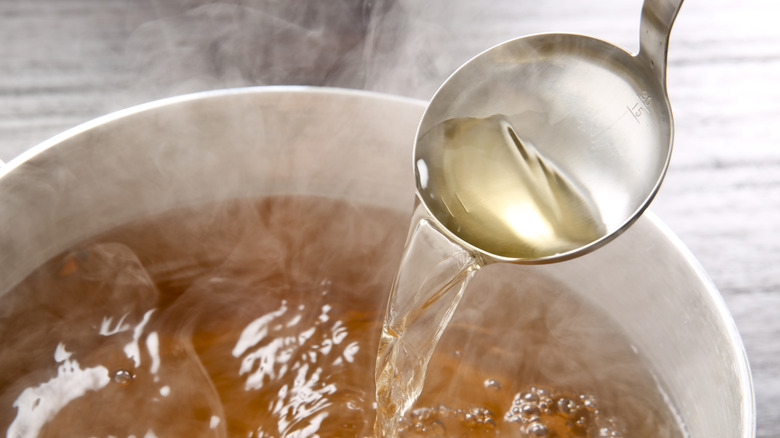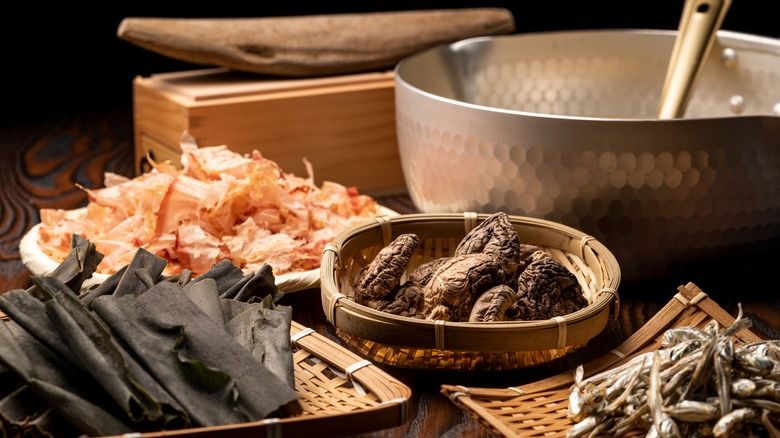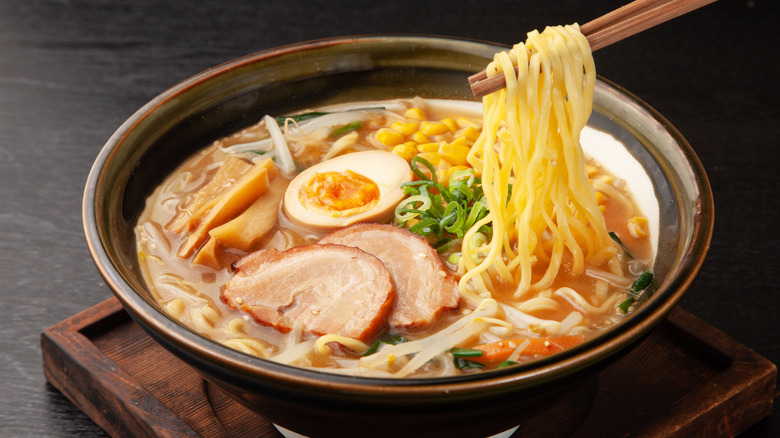What Makes Dashi Unique
There are few foods as comforting and simple as a hot bowl of soup, but in reality there's a lot more going on behind the scenes than meets the eye. A soup is so much more than just tossing everything into a pot. A well-executed bowl of soup is an artful, varied layering of flavors, featuring ingredients with a nourishing balance of taste and texture. But the most famous part of soup is its slurpable, spoonable liquid element of either stock or broth, and sometimes a milky addition like cream or coconut milk. After all, that's what makes it soup!
Alton Brown explains that stock is based on bones, joints, and connective tissue, while less substantial broth is simply liquid that's had meat (or meaty bones, according to Kettle & Fire) cooked in it. It's important to note that vegetables, herbs, and seafood shells can be used for stock, too. Recently, the health food scene has been inundated with trendy bone broth – and that comes from simmered animal bones and connective tissue (per Healthline). Kettle & Fire explains that bone broth is actually mostly similar to stock. In Japanese cooking, though, you'll find a special kind of stock called dashi that uses some surprising ingredients to great effect.
What is dashi?
Dashi has a much shorter ingredient list than many other stocks. Taste Atlas explains that dashi is usually made up of dried kelp (kombu) and katsuobushi (dried, fermented, smoked bonito or skipjack tuna flakes), to produce a deeply savory (umami) cooking liquid. MasterClass names a few variations that can contain soy sauce, rice wine, anchovies, sardines, and shiitake mushrooms. The James Beard Foundation reports that dashi's special powers come from the ingredients' glutamic acid and sodium inosinate, which naturally produce the umami taste we commonly associate with MSG (monosodium glutamate).
To make dashi, the ingredients are simply simmered for far less time to produce a light-colored, more delicate result than heavier and richer meat stocks. While you can buy premade dashi online and at Asian food markets, it's more fun to learn it from Iron Chef Morimoto (via Andrew Zimmern). Taste Atlas says that it is the foundation of miso soup and noodle soups like ramen and udon, but also the basis for egg and batter dishes and hearty stews like chankonabe.
Cooking with dashi
With dashi up your sleeve, you'll unlock the secrets of dishes like Nobu Matsuhisa's Miso Soup (via Martha Stewart) and ramen inspired by David's Chang's from Momofuku (via Food Noveau). Dashi's two core ingredients of kombu and katsuobushi last a long time and are good to have on hand for elevating a humble bowl of instant ramen. You can also take it upscale with Chef Lee Chizmar's lobster dashi broth or keep it classic with beef udon from Just One Cookbook. Dashi is experiment-friendly, and can be used to make sauce or paired with rice.
If you've been inspired by dashi's subtle strength, you'll be intrigued to know that many soups, stews, and other slow-cooked dishes depend on more than just the liquid. Taste of Culture explains that in Japanese cuisine, sa shi su sé so refers to the abbreviated names and order by which you add sugar, salt, vinegar, soy sauce, and miso. French cooking employs mirepoix, which is a flavor base made of butter-sauteed, evenly-cut carrots, onions, and celery (per Food Network). Likewise, there's sofrito in Latin cuisines — a puree of onions, peppers, garlic, and cilantro cooked in oil, along with many more bases around the world. Now that you know the secrets of stellar soup, it's time to consider the cooking pot your next culinary canvas.


